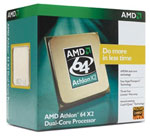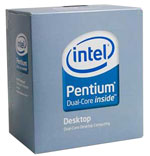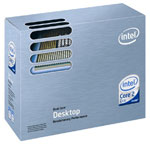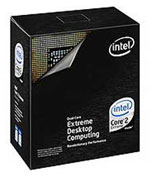Holiday Buyers Guide, Part I: CPUs, GPUs, Mobos, and RAM
by Editorial Staff on November 21, 2007 2:01 PM EST- Posted in
- Guides
A Plethora of Processors
For the past year, AMD simply hasn't been able to compete with Intel's Core 2 Duo on performance alone. AMD tried to recover from the initial Core 2 beating by competing mostly on price, and an aggressive price war followed with several major altercations in late 2006 and 2007. The war may not have done any favors for AMD - or even Intel - but the public has been rather pleased with the slew of cheap and high performance AMD and Intel processors. In the meantime, both companies have been hard at work on the second phase of the battle. Intel has their 45nm process technology primed to up the stakes, and AMD "Barcelona Project" hoped to lead a counterattack and regain lost ground. With the release of AMD's Phenom architecture, many hoped (us included) for a successful return of AMD as a player in the enthusiast/high-end market. Sadly, the first salvo appears to have fallen short.
What remains is a processor landscape that isn't very different from what we've covered in our most recent Buyers' Guides. If you already have an AM2 platform, or if you're looking at something for the budget sector, AMD has some processors that are worth a closer look. For pure performance and/or overclocking, Intel continues to be the leader. Even in the entry-level market, Intel competes quite well with Pentium Dual-Core processors priced well under $100. Less expensive motherboards are the saving grace for AMD's budget-conscious offerings.
Entry-Level
 |
(Brisbane 2.1GHz 2x512K socket AM2 65W)
This is not the cheapest AMD processor, but AMD's X2 4000+ represents fantastic value for those looking for a basic entry-level workstation or home office PC. If you measure heavy usage in terms of how many emails you send in one day rather than your highest 3DMark06 or Crysis timedemo scores, there's no need for anything faster. Even for an entry-level PC, there is always the option to slap in a video card and fire up a game, and the X2 4000+ is no slouch there. Manufactured on the 65nm die process, the Brisbane 4000+ has a lower TDP of 65W than its 90nm predecessors. Running at 2.1GHz, it provides more than enough power for day-to-day activities, while giving users who wish to dabble in overclocking a nice, cheap alternative to an upgrade.
 |
(Allendale 1.6GHz 800FSB 1MB socket LGA775)
The Allendale-based E2140 is the lowest CPU based on Intel's Core 2 Duo architecture, running at 1.6GHz with an FSB of 800MHz and utilizing just 1MB of shared L2 cache. Don't be fooled by the low specs, however, as reports of users attaining a 100% overclock (3.2GHz, 1600FSB) are common, putting this processor firmly into the top spot for those who don't want to spend insane amounts on PCs, but instead want the absolute best bang-for-buck. Who wouldn't, when an E2140 at 3.2GHz is only ~10% slower than the $280 3GHz E6850? People who don't mind spending an extra $10-$15 can upgrade to the E2160 or E2180 (1.8GHz and 2.0GHz respectively) which both come with higher FSB multipliers.
Lower-Midrange/Overclocking
 |
(Allendale 2.2GHz 2M socket LGA775 65W)
The E4500 at stock is faster than the X2 5000+, and is a great processor for those wanting to overclock on a budget. Based on the Allendale core with 2MB of shared L2 cache, this is a minor step up from the 2.0GHz E4400, but with prices often favoring the E4500 these days there's no reason to pick up one of the lower E4x00 models. The added cache relative to the Pentium Dual-Core offerings accounts for about 10% more performance at the same clock speed, and while you can try to increase clock speed, there's no way to add cache without spending a bit more money. With default voltages of 1.185V, the E4xxx series are renowned for running very cool. Users are reporting overclocks of 3.2GHz with ease; just be sure to pair it up with a good motherboard/DDR2 combination if overclocking is the goal.
 |
(Brisbane 2.6GHz 2x512K socket AM2 65W)
For those needing an entirely new PC, we'd go the Intel route on this one. The Core 2 Duo is simply superior to K8; even with Phenom now available, we still recommend Intel's LGA775 over AM2. Penryn processor support (on the appropriate motherboard) only makes the platform more attractive for enthusiasts. That said, we've included the X2 5000+ Black Edition for users with an existing AM2 motherboard and who are looking to upgrade. The Black Edition's hallmark is its unlocked multiplier; effectively making this CPU one of the bargain buys of the year. Why? By simply dialing up the multiplier and keeping the HyperTransport bus at stock, overclocking is an effortless task. Reports of users hitting 3.4GHz are common, and even at stock speed the Black Edition is still competitive to its nearest Intel rival, the E4500. You'll need to purchase an aftermarket CPU heatsink as the Black Edition does not include one, but for anyone remotely interested in overclocking that's pretty much a given already.
Upper-Midrange/High-End
 |
(Kentsfield 2.4GHz 2x4MB socket LGA775)
Arguably the most popular CPU right now, the quad-core Q6600 once again stakes its claim as one of the best bang-for-the-buck options. You can get similarly priced quad-core courtesy of the Phenom 9500 (2.2GHz), but with the Q6600 generally besting even the not-yet-available Phenom 9900 (2.6GHz) we see no reason to go that route, unless you already have an AM2 motherboard and don't mind second-class performance. This is perhaps the final hurrah for the Q6600, as the faster, slimmer, and more overclocking friendly Q9450 is due out in January of next year. That may necessitate the purchase of a Penryn compatible motherboard, however, so if you don't feel like waiting there's still plenty to like with the Q6600.
There's still a shortage of software that benefits from more than two cores; however video encoding, 3D rendering, and certain other tasks will appreciate the extra cores. It may be some time yet before games truly benefit from quad-core, but for $260 you can be ready today for whatever CPU requirements the software of tomorrow brings. If you don't mind overclocking, with appropriate cooling we've also hit over 3.4GHz. Just don't look too closely at the power use of the CPU when you're overclocked that far. Alternately, if you don't want to overclock but you still want improved CPU performance for dual-core applications, consider the E6850. Clocked at 3.0GHz and priced only slightly higher than the Q6600 ($276), for games you will still end up with better performance and less power use by going the dual-core route. (E6550 and E6750 are also reasonable options, naturally.) If you want more than the Q6600, we wouldn't bother with the Q6700. At roughly twice the price, we'd recommend a minor overclock first. Otherwise, you might as well just go all out and grab our extreme recommendation....
Extreme Performance
 |
(Yorkfield 3.0GHz 2x6MB socket LGA775 130W 45nm)
After months of information trickling out regarding Penryn and Intel's move to a 45nm manufacturing process, the major benefits appear to be the increase of L2 cache (2x6MB vs. 2xMB on the Q6xx0) and the reduction in power consumption. SSE4 is also present in Penryn, but application support for the new instructions is relatively limited. Despite its evolutionary nature, Penryn is a worthy successor to the Core 2 line. This is not yet a native quad-core design like AMD's Phenom X4, but Intel's approach of pairing two processor dies onto one package seems to be holding its own. Weighing in with approximately 820 million transistors, the QX9650 comes clocked at 3.0GHz with a system bus frequency of 1333MHz, and is a behemoth of a processor. The 130W TDP is anything but tame, but then you don't expect the heavyweight champion of the CPU world to get by eating only vegetables and fruits.










23 Comments
View All Comments
guptasa1 - Thursday, November 22, 2007 - link
Any chance I can get a clarification on this?Planning to buy soon (possibly this friday) and actually like the looks of the X38T - what's inferior about it to the Asus? (Asus was my second choice.) If it's just benchmarks, BIOS updates may address that, but if it's being revised due to a problem or something, I'd like to know. Thanks. (Great roundup btw.)
vailr - Wednesday, November 21, 2007 - link
Fry's BF ad has a Q6600 + ECS motherboard combo priced at: $198. "Limited to 1 per customer. No substitutions, no rainchecks."http://downloads.bfads.net/BFAds-Frys-San-Diego.pd...">http://downloads.bfads.net/BFAds-Frys-San-Diego.pd...
Jodiuh - Wednesday, November 21, 2007 - link
"...but new buyers will prefer to experience the goodness of two 8800 GT cards running Crysis."I would like to experience this goodness, but I've gotten bsod's and poor performance in Vista x64 and 2 frames more in XP when NOT using SLI. :( Guide! Guide!!
CrystalBay - Wednesday, November 21, 2007 - link
Crossfire 3850's smoke despite their 256 Vram disadvantage...Le Québécois - Wednesday, November 21, 2007 - link
On page 5 : " Let's not even get into a discussion of performance requirements for Crysis, Hellgate: London, or Unreal Tournament 2007. "Epic has changed the name to Unreal Tournament 3 for a while now.
Also on page 5: " We showed in our recent HD 3870 article that CrossFire performance roughly matches what you get from a single 8800 GTX "
If I remember correctly, Anand stated that he could only test the HD 3850 in Crossfire and almost had to beg to receive ONE HD 3870 from AMD. If Crossfire HD 3850 is more or less equal to a single 8800GTX, can't we expect Crossfire HD 3870 to be more powerful than that?
JarredWalton - Wednesday, November 21, 2007 - link
Updated. I actually missed that it was 3850 CF vs. the 8800 GTX. Of course, we still have to deal with the fact that CrossFire often doesn't work properly on new games until a driver update. AMD is working to address that concern apparently, and we should see profiles in their drivers (finally!) at some point soon.SerpentRoyal - Wednesday, November 21, 2007 - link
P35 Neo2-FR is $100 after rebate. Abit has an equivalent in the form of IP35 for $95 after rebate. IP35 is identical to IP35-E, plus six SATA ports, 1394a, heat pipe cooling, and ICH9R for on-board RAID. LAN port sits on PCI-E.IP35 and IP35-E share the basic power module section found in the IP35 Pro. Their on-board CPU and fan headers can also control the speed of a 2-wire fan. The stock 11 BIOS is stable and can easily hit 490MHz FSB with a capable CPU.
I'll make it easy for the editor to pick the winner. Let's compare the P35 Neo2-FR against the two Abit boards. Abit IP35-E has been selling for $65 to $70 after rebate since September 2007. It's 30% cheaper than the MSI because it doesn't come with RAID, eSATA. Board has four SATA ports instead of five on the MSI. Abit IP35 adds RAID, 1394, and six SATA ports. IP35 lacks eSATA, but it's $5 cheaper than the P35 Neo2-FR.
http://www.mwave.com/mwave/viewspec.hmx?scriteria=...">http://www.mwave.com/mwave/viewspec.hmx?scriteria=...
kd4yum - Wednesday, November 21, 2007 - link
" some of our suggestions might indicate we do not like our friends or family members. "...love this one.
.
pauldovi - Wednesday, November 21, 2007 - link
Where is the GA-P35-DS3L and GA-P35-DS3R in the motherboard sections. The DS3L is a $85 motherboard that is amazing. The -R is the same with with RAID capability. They easily match those $200 range boards.G.Skill has a 4GB kit on newegg for $120. If that isn't a deal I don't know what is.
retrospooty - Wednesday, November 21, 2007 - link
"Where is the GA-P35-DS3L and GA-P35-DS3R in the motherboard sections."Ummm... Page 4? ;)
http://www.anandtech.com/guides/showdoc.aspx?i=315...">http://www.anandtech.com/guides/showdoc.aspx?i=315...